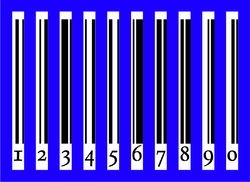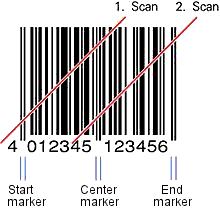The GTIN numbers, encoded to UPC-A, EAN-8 and EAN-13, all use similar encoding. The encoded data is usually repeated in plain text below the barcode.
Encoding of the digits
To encode the 13-digit EAN-13 number, the digits are split into 3 groups; the first digit, the first group of 6 and the last group of 6. The first group of 6 is encoded using a pattern whereby each digit has two possible encodings, one of which has even parity (denoted with letter G) and one of which has odd parity (denoted with letter L). The first digit is not represented directly by a pattern of bars and spaces, but is encoded indirectly, by selecting a pattern of choices between these two encodings for the first group of 6 digits, according to the table below. All digits in the last group of 6 digits are encoded using a single pattern RRRRRR, the one also used for UPC.
If the first digit is zero, all digits in the first group of 6 are encoded using the pattern LLLLLL used for UPC; therefore, a UPC barcode is also an EAN-13 barcode with the first digit set to zero.
Structure of EAN-13| First digit | First group of 6 digits | Last group of 6 digits |
|---|
0 | LLLLLL | RRRRRR |
1 | LLGLGG | RRRRRR |
2 | LLGGLG | RRRRRR |
3 | LLGGGL | RRRRRR |
4 | LGLLGG | RRRRRR |
5 | LGGLLG | RRRRRR |
6 | LGGGLL | RRRRRR |
7 | LGLGLG | RRRRRR |
8 | LGLGGL | RRRRRR |
9 | LGGLGL | RRRRRR |
This encoding guarantees that the first group always starts with an L-code, which has odd parity, and that the second group always starts with an R-code, which has even parity. Thus, it does not matter whether the barcode is scanned from the left or from the right, as the scanning software can use this parity to identify the start and end of the code.
EAN-8 barcodes encode all digits directly, using this scheme:
Structure of EAN-8| First group of 4 digits | Last group of 4 digits |
|---|
LLLL | RRRR |
Encoding of the digits| Digit | L-code | G-code | R-code |
|---|
0 | 0001101 | 0100111 | 1110010 |
1 | 0011001 | 0110011 | 1100110 |
2 | 0010011 | 0011011 | 1101100 |
3 | 0111101 | 0100001 | 1000010 |
4 | 0100011 | 0011101 | 1011100 |
5 | 0110001 | 0111001 | 1001110 |
6 | 0101111 | 0000101 | 1010000 |
7 | 0111011 | 0010001 | 1000100 |
8 | 0110111 | 0001001 | 1001000 |
9 | 0001011 | 0010111 | 1110100 |
Note: Entries in the R-column are bitwise complements (logical operator: negation) of the respective entries in the L-column. Entries in the G-column are the entries in the R-column in reverse bit order. See pictures of all codes against a colored background.
A run of one or more black areas is known as a "bar", and a run of one or more white areas is known as a "space". As can be seen in the table, each digit's encoding comprises two bars and two spaces, and the maximum width of a bar or space is four areas.
Decoding
By utilizing the barcode's center marker, a scanner can decode an International Article Number (EAN) by scanning one half of the barcode at a time through a helical scan at a 45-degree angle. This method reconstructs the full code from partial scans, useful when the barcode is obscured or damaged. Error detection algorithms, such as checksum verification, play a crucial role by identifying and correcting scanning errors, ensuring accurate decoding. Additionally, modern scanners often employ omnidirectional scanning, enhancing their ability to read barcodes at various angles.
These scanners also leverage the symmetrical structure of EAN-13, allowing decoding from either direction. Error detection algorithms, like the Luhn algorithm, commonly used in checksum calculations, verify the integrity of the data scanned. If errors are detected, the scanner can either alert the user or attempt correction, improving the reliability of scanning in dynamic or less-than-ideal conditions.








